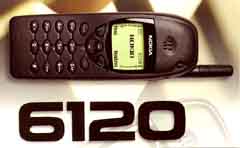

TECH NOTES NOKIA 6120 IN DEPTH - Last Updated 28-12-98
- NOKIA 6120 MODEM ADAPTER (taken from usenet): The DAR-3 modem data adapter from Nokia (for 6120 and 6160/1/2) is finally available. The package suggests it is to be used with 3Com modems and cables, but that is not the case (marketing alliance!) I was able to use the DAR-3 just fine with an Apex Data PC card and cable with pretty good results. It puts the phone into analog mode for the data transmission just like it's supposed to. The adapter connects to the bottom of the phone and then uses the modem's direct connect cable for the Nokia 2120/2160 (good news I suppose for those that already had that cable).
- Understanding the FIELD TEST OPTIONS that appear on the LCD screen: Note: this is not complete, and has been extracted from the technical manual of the 2160, which happens to be very similar. I took this information from:
http://www.globility.com/~lamj/nokia/fieldtest.html
The field test is mainly for those hard-core cellular phone users that really know what they are doing. The default of field test mode is "disabled". It can be enabled in the programming mode by entering *3001#12345# in normal mode and select "Field Test" and select the correct option to enable it. After power-off and on again, you should see some strange information on your LCD screen, that's the information of the field test. The display only gives out the results and omitted the keys of what these information refers to. By holding the # key for 1 second, the key for the current screen is displayed. However, the keys is still in shortform and furthur description is needed to understand what those digits means.
Since the field test mode of 616X is very similar to a 2160 and 2168, the following is from a document about the field test mode of a 2160 written by Brian Oblivion. This document is archieved at http://www.tdyc.com/archive/oblivion/nokia/nok2160tst.html THANKS A LOT TO BRIAN FOR THESE INFORMATION.
Screen 1 - CS Display
(Digital control (Digital traffic (Analog control (Analog voice
channel mode) channel mode) channel mode) channel mode)
+----------+ +----------+ +----------+ +----------+
|rssi DVC S| |rssi s d| |rssi D d| |rssi DVC S|
|chan Pw A| |chan l a| |chan Pw A| |chan l a|
|CS-state | |CS-state | |CS-state | |CS-state |
+----------+ +----------+ +----------+ +----------+
rssi = received Signal strength (dBm) [min= -113dBm, max= -51dBm, 2dB steps]
DVC = Digital Verification Color Code [1-255, - = not locked]
D = DCC (Digital Color Code) on Analog Control CHannel [0-3,
- = not locked]
s = SAT color [0-2, - = not locked]d = data receiving status
0 = no sync/no data
1 = sync/ not able to read
2 = reading correcting
3 = reading no correction
S = slot [1-3]chan = Channel [0001-1023] This is the site ID that you are connected to.
Pw = Max access power
DCCH: MS-ACC-PWR [0-10, - = not locked]
ACCH: CMAC [0-7, - = not locked]
l = Tx level [0-10, - = TxOff]A = ?
a = audio state [0=off, 1=on]CS-state = Cellular State
DCCH: SCAN-LOCK : Scanning and locking of DCCH
DCCH: DCCH-SEL : DCCH selection
DCCH: CAMPING : Camping
DCCH: REGISTR : Registration proceeding
DCCH: WAIT-ORDER: Waiting for order
DCCH: ORIGINAT : Origination proceeding
DCCH: RSELECT : Reselection
DCCH: ORIG-SMS : Origination SMS proceeding
DCCH: TERM-SMS : Terminated SMS proceeding
DTCH: TCH : Confirm traffic channel
xTCH: CONVERSAT : Conversation
ACCH: OOR : Out of range
ACCH: SCAN-PDCH : Scan primary dedicated control channels
ACCH: SCAN-SDCH : Scan secondary dedicated control channels
ACCH: SCAN-PCH : Scan paging channels
ACCH: IDLE : Idle
ACCH: ACCESS : Access
ACCH: VCH : Confirm voice channel
Screen 2 - CS Display
(Digital control (Digital traffic (Analog control (Analog voice
channel mode) channel mode) channel mode) channel mode)
+----------+ +----------+ +----------+ +----------+
|mode M C| |mode DTX| |mode | |mode |
|FB E SP pc| |ENCR CIPH| |XSTBY | | |
|net SID| |d a Be TA| | SID| | SAT |
| | |.CODEC. | | | | |
+----------+ +----------+ +----------+ +----------+
mode = DCCH, DTCH, ACCH, AVCH
SID = system ID [0-32767, - = not locked]DCCH:
M = maximum paging frame class supported by network [1-8]
C = current PFC (paging frame class) [1-8]
FB = number of F-BCCH slots
E = number of E-BCCH slots
SP = number of SPACH slots
pc = PCH subchannel
net = supported network types, bit map [1=suported, 0=not, C=current]
X = Public
X = Private
X = ResidentialDTCH:
DTX = ?
ENCR = shown when message encryption is on
CIPH = shown when voice ciphering is on
d = data receiving status [0=no sync, 1=sync]
Be = Bit error rate in % [0-16]
TA = current time alignment [0-30]
CODEC = which voice encoding scheme is usedACCH:
XSTBY= shown when extended standby is onAVCH:
SAT = SAT validity as measured by DSP [0-32767]
SCREEN 3:
+----------+
|RS SS SI b|
|NA ND |
|MA MD MO |
+----------+RS = minimum Seceived signal Strength required to access cell [0-31]
SS = minimum signal Strength Sufficient for candidate of reselection
SI = Scan Interval between consecutive strength measurements in
hyperframes [1-16]
b = access burst sze [0=normal, 1=abbreviated RACH]
NA = Number of Analog neighbors [0-24]
ND = Number of Digital neighbors [0-24]
MA = ?
MD = ?
MO = ?
After you finish with the features of field test and want to disable field test mode, there is an easier way, just goto "menu" and there will be a new option "Field Test" and it will let you select a number. Just enter 00, this will temperary disable field test mode. When you want to enable it again just select the page number ie. 02 then the field test mode will be enabled again and will display field test page 2. .